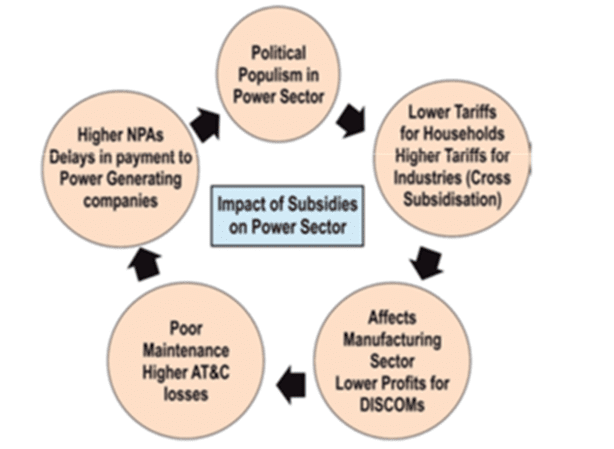Economy: November 2021 Current Affairs | Indian Economy for State PSC Exams - BPSC (Bihar) PDF Download
1. Discoms: Present Status, Challenges and Strategies
India has made rapid strides in power sector. It is the third largest producer of electricity and almost every citizen has access to grid electricity. However, power distribution continues to be the weakest link in the supply chain of the power sector. Most of the DISCOMs incur huge losses, which in turn reduces their ability to pay dues to the power generating companies and repay loans to the Banks. The poor financial health of the DISCOMs can cause negative domino effect on the economy.
- Reasons For Poor Financial Position of DISCOMs The DISCOMs have incurred heavy losses around Rs 75,000 crores in 2020-21 due to structural, operational and managerial inefficiency.
- Higher Cost of Power Procurement: Power procurement accounts for almost 80% of the expenditure of the discoms. Discoms have entered into expensive and long-term thermal Power purchase agreements (PPAs) based on incorrect estimates of power demand. So, even though, the cost of electricity in the open market has reduced, the DISCOMs continue to purchase electricity from the thermal power companies at higher cost due to PPAs.
- Lack of Independence and Autonomy: The Electricity Amendment Act, 2003 has provided for State Electricity Regulatory Commissions (SERCs) to ensure independence and autonomy in fixing electricity tariffs. However, there is political interference in fixing tariffs leading to lower tariffs on electricity.
- Cross-Subsidization of Tariffs: The DISCOMs have increased the electricity tariffs for the industries to compensate for the losses. This in turn has forced the industries to avail benefits under the Open Access Policy. Under the Open Access Policy, bulk consumers (> 1 MW) can purchase electricity directly from the open market (Power exchanges, direct agreement with the power generating companies etc.). So, since the DISCOMs supply electricity to Industries at higher tariffs, the industries have shifted to buying electricity at cheaper rates directly from open market.

- Higher AT&C losses: The higher losses have reduced the ability of the DISCOMs to upgrade their infrastructure and provide reliable and continuous electricity. The Aggregate Technical and Commercial (AT&C) losses of the DISCOMs has increased to 22% on account of Transmission losses, Commercial losses due to power theft, absence of metering and inefficiencies in bill collection etc. The global average for AT&C losses is much lower at 8% (USA- 6%; China- 8%).
- Higher Dependence on State Governments: The DISCOMs depend on the state governments for the subsidies. Delays in receiving subsidy reimbursements from the government add to the liquidity stresses of discoms.
- Monopolisation: Presently, DISCOMs enjoy monopoly in distribution of electricity leading to absence of discoms.
- UDAY Scheme: Aims at improving the financial position of DISCOMs. Under the scheme, states are supposed to take over 75% of the discoms’ debt and the DISCOMs were required to reduce AT&C losses to 15%.
- Saubhagya Scheme: Free electricity connection to all households (both APL and poor families) in rural areas and poor families in urban areas. Reforms based Results linked Revamped
- Power Distribution Scheme: Help DISCOMs improve their operational efficiencies and financial sustainability by providing result-linked financial assistance to DISCOMs to strengthen supply infrastructure based on meeting pre-qualifying criteria and achieving basic minimum benchmark. Under this scheme, the DISCOMs are required to reduce AT&C losses to 12-15% by 2024-25. Private Participation and Competition in competition, higher inefficiencies and poor service delivery.
Distribution Sector Reforms
Electricity Amendment Act, 2003
- Established regulatory bodies - Central Electricity Regulatory Commissions (CERCs) and State Electricity Regulatory Commission (SERCs).
- Appellate tribunal for dispute resolution.
- Introduction of competition through Open Access policy
- Delicensing of Thermal Generation
- Introduction of Renewable Purchase Obligation Policy (RPO) which requires DISCOMs to procure certain percentage of their electricity needs from Renewable energy.
Deen Dayal Upadhyaya Gram Jyoti Yojana–DDUGJY: Focuses on feeder separation (rural households and agricultural) and strengthening of sub-transmission and distribution infrastructure in rural areas. It is meant to provide round-the-clock power to rural households and adequate power to agricultural consumers.
Distribution: Some states have promoted private participation in the DISCOMs through (a) Franchise Model and (b) Privatisation of DISCOMs. (a) Under the Franchise model, the private entity has no ownership of distribution grid assets. The private party manages billing and revenue collection. Example: Bhiwandi, Maharashtra. (b) In case of privatisation, the private entity not only manages the billing and revenue collection but also owns the distribution grid. Example: Privatisation of Delhi Vidyut Board in 2002.
Retail Choice to Consumers: Presently, the DISCOMs enjoy monopoly in distribution of electricity which in turn leads to lack of consumer choice and higher inefficiencies. Hence, the Union Budget 2021-22 has sought to introduce competition in the distribution sector and provide retail choice to the consumers.
Privatisation of DICOMs: The Centre has announced that it would privatise the DISCOMs in all the Union Territories.
Strategies to Improve the Distribution Sector
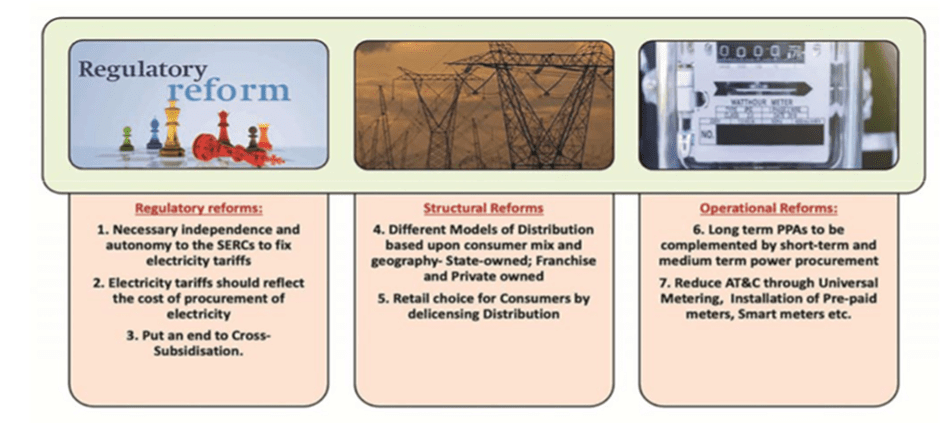
2. PM Mitra Scheme
The Government has recently launched the PM MITRA Scheme, which was earlier announced in the Union Budget 2021-22. The scheme enables the textile industry to become globally competitive, attract large investments, boost employment generation and exports.
Factsheet of Indian Textile Industry
- India’s textiles sector is one of the oldest industries in the Indian economy, dating back several centuries.
- The Indian textiles and apparel industry contributed 2% to the GDP, 12% to export earnings and accounted for 5% of the global trade in textiles and apparel in 2018-19
- It is the second largest producer of MMF Fibre after China and sixth largest exporter of Textiles & Apparel in the world.
- Provides employment to around forty-five million people.
Details About PM Mitra Scheme
- Vision: 5F vision PM Modi. The '5F' Formula encompasses - Farm to fibre; fibre to factory; factory to fashion; fashion to foreign.
- Scope: Set up 7 PM Mega Integrated Textile Region and Apparel (PM MITRA) Parks in Greenfield/Brownfield sites in partnership with the willing State Government.
Nature of Incentives
- Incentives to MITRA Parks: Government to provide capital support of 30% of the project cost in Greenfield/Brownfield parks. The support would lead to creation of Core Infrastructure such as Developed Factory Sites, Plug & Play facility, Incubation Centre, Roads, Power, Water and Wastewater system etc.
- Incentives to Industries: Up to 3% of the total sales turnover. This is only available to those manufacturing companies who are not availing benefits under Textile PLI scheme. Operational Model: Public Private Partnership (PPP) model based on Design-Build-Finance-Operate-Transfer (DBFOT) format. SIGNIFICANCE OF SCHEME
- Reduce Logistics Cost: The logistics cost accounts for 12-14% of the GDP, which is higher in comparison to global benchmarks. The higher logistics cost reduces the manufacturing competitiveness of Indian textile Industry. The PM MITRA Scheme will reduce logistics cost and strengthen the value chain of the textile sector making it globally competitive.
- Employment Opportunities: Higher GDP growth rate in India has failed to translate into higher employment opportunities. In this regard, Economic Survey 2017-18 has highlighted the need to focus on Labour Intensive Industries such as Textiles and Leather. The Economic Survey had highlighted that Apparels are eighty times more labour-intensive than automobiles and create 240 fold more jobs than steel.
- Women Empowerment: Textile Industries employ more women and hence are considered as vehicles for socioeconomic transformation. For example, in Bangladesh, female education, total fertility rates, and women’s labour force participation have improved due to the rapid expansion of the textile sector.
- Historic Opportunity: India has an opportunity to promote Textile Sector because of rising wage levels in China. India is well positioned to take advantage of China’s deteriorating competitiveness because wage costs in most Indian states are significantly lower than in China.
- Sustainable growth: help India in achieving the UN Sustainable Development Goal 9 (“Build resilient infrastructure, promote sustainable industrialization and foster innovation”).
3. Gati Shakti- National Master Plan
PM has recently launched the Gati Shakti Master Plan – National Master Plan for Multi-modal Connectivity. The Gati Shakti platform would provide Gati (Speed) and Shakti (Strength) for integrated planning and coordinated implementation of infrastructure connectivity projects.
Current Problems in Infrastructure Lack of Coordination between different Ministries/ Departments.
Most of the Government ministries work in silos without adequate coordination with other agencies. For example, once a road is constructed, other agencies dug up the constructed road again for activities like laying of underground cables, gas pipelines etc.
- Time and Cost overruns: According to Ministry of Statistics and Programme Implementation, one out of every five infrastructure projects have a delay of over five years. Further, delays in execution of projects have led to increase in cost by almost 4.5 lakh crores, amounting to 80% of our capital expenditure in 2021-22.
- Huge difference between macro planning and micro implementation: Different departments are not even aware which department is preparing to start which project and where. Similarly, the private sector is also not aware about the new infrastructure projects being planned and executed. Prior idea about such infrastructure projects can lead to higher private sector investment.
About PM Gati Shakti PM
Gati Shakti is supposed to break departmental silos and institutionalize holistic planning for stakeholders across major infrastructure projects. The PM Gati Shakti will ensure that India of the 21st century does not waste money or time due to lack of coordination in infrastructure projects. Under the PM Gati Shakti National Master Plan, everything, from roads to railways, from aviation to agriculture, various ministries and departments would be linked.
- National Master plan for Multi-modal connectivity
- Seeks to bring 16 Ministries together for integrated planning, design and execution of infrastructure projects.
- Monitor projects worth Rs 100 lakh crores.
- Incorporate the infrastructure schemes of various Ministries and State Governments like Bharatmala, Sagarmala, UDAN etc.
- Economic Zones like manufacturing clusters, defence corridors, electronic parks, industrial corridors, fishing clusters, agri zones will be covered to improve connectivity & make Indian businesses more competitive.
- Leverage technology including spatial planning tools with ISRO imagery developed by BiSAG-N (Bhaskaracharya National Institute for Space Applications and Geoinformatics).
Note: An empowered group of secretaries, headed by the Cabinet secretary, will be formed to review and monitor the implementation of PM Gati Shakti. The Department for Promotion of Industry and Internal Trade (DPIIT) will be the nodal ministry.
How is Gati Shakti Different From National Infrastructure Pipeline?
Under the National Infrastructure Pipeline (NIP), the Government has identified infrastructure projects worth Rs 111 lakh crores which it will be constructing in the five years between 2021-2025. The Implementation of NIP requires coordination and integrated planning between multiple ministries and departments. Such an integrated and holistic approach to infrastructure creation would be provided through the Gati Shakti.
4. Pillars of Gati Shakti
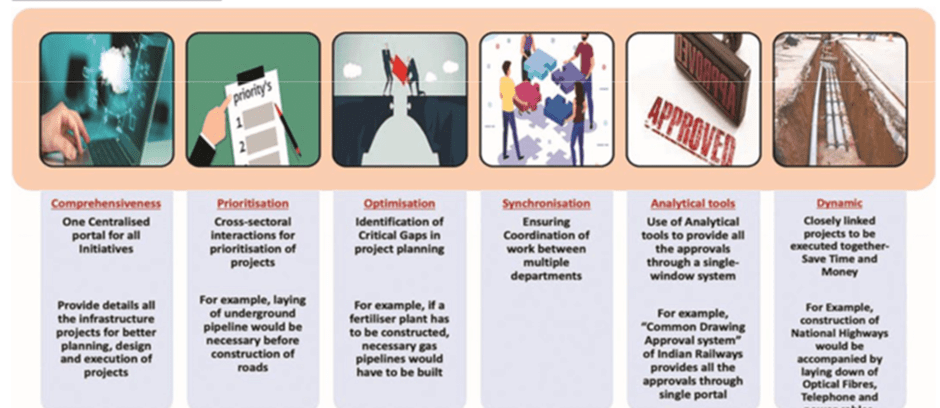
Benefits
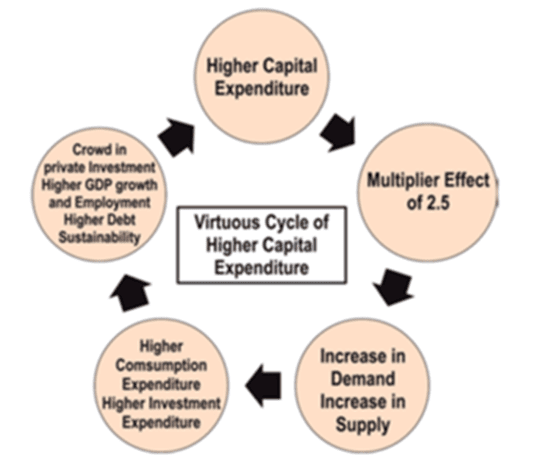
- Local Multiplier effects: In India, the capital expenditure multiplier is around 2.45, while the revenue expenditure multiplier is 0.99 (RBI Bulletin, Dec 2020). Thus, for a Rs. 1 crore increase in capital expenditure, GDP increases by Rs. 2.45 crores, whereas 1 crore increase in revenue expenditure, the GDP increases only by Rs.0.99 crore. Hence, Capital Expenditure has the potential to revive both demand and supply leading to expeditious economic recovery and creation of more employment opportunities.
- Promote Industrial Development: Provide multi-modal connectivity to Economic Zones like manufacturing clusters, defence corridors, electronic parks, industrial corridors etc.
- Ensure efficient implementation of Infrastructure projects: Promote inter-ministerial and interdepartmental coordination and hence reduce time, cost overruns, and improve ease of living for the people. To sum up, PM Gati Shakti plan will break interministerial silos, enhance India's global competitiveness through next-generation infrastructure and seamless multi-modal connectivity, ensure seamless movement of goods and people and enhance the ease of living as well as the ease of doing business.
5. Capital Account Convertibility
Recently, the Deputy Governor of the RBI, Rabi Shankar gave a speech on "India's Capital Account Management- An Assessment". In this regard, let us look at various aspects of Currency Convertibility.
Currency Convertibility
- Currency convertibility refers to the freedom to convert the domestic currency into other internationally accepted currencies and vice versa. Convertibility in that sense is the easing of controls or restrictions on currency transactions. The convertibility of currency can be in the form of either Current Account Transactions or Capital Account Transactions.
Rupee Convertibility in India
- Full Rupee Convertibility on Current Account: The Current Account under the Balance of Payment (BoP) includes various transactions such as Imports, Exports, Remittances, Gifts, Donations. On these transactions, India has adopted full Rupee Convertibility in 1993.
- That means there are no unnecessary restrictions on these transactions. Rupee can easily be converted into foreign currencies and vice-versa on these transactions.
Partial Rupee Convertibility on Capital Account
- Capital Account Convertibility (CAC) is not just the currency convertibility, but it also involves the freedom to invest in financial assets of other countries. The Committee on Capital Account Convertibility (1997) headed by Tarapore has given a working definition for the CAC - “CAC refers to the freedom to convert local financial assets into foreign financial assets and vice versa at market determined rates of exchange.
- It is associated with changes of ownership in foreign/domestic financial assets." So, it refers to easing of restrictions on movement of capital (such as FDI, FPI etc.) from one country to another. India has adopted Partial Rupee Convertibility on Capital account.
There are certain restrictions which are imposed on the movement of Capital as shown below:
- Restrictions on FDI: There are certain sectors (such as Gambling/Lottery, Chit Funds and Nidhi Companies, Manufacturing of Cigarettes etc.) where FDI is prohibited.
- 100% FDI is not allowed in all the sectors. The Government has imposed Sectoral Cap on FDI in different sectors.
- In some sectors such as Banking, Insurance etc., investment through FDI is allowed after the Government's approval.
- Restrictions on FPI: Individual and Aggregate FPI Limit, FPI Limit in G-Secs and Corporate Bonds etc.
- External Commercial Borrowings: RBI sets annual limits.
Pros and Cons of Full Rupee Convertibility on Capital Account Transactions
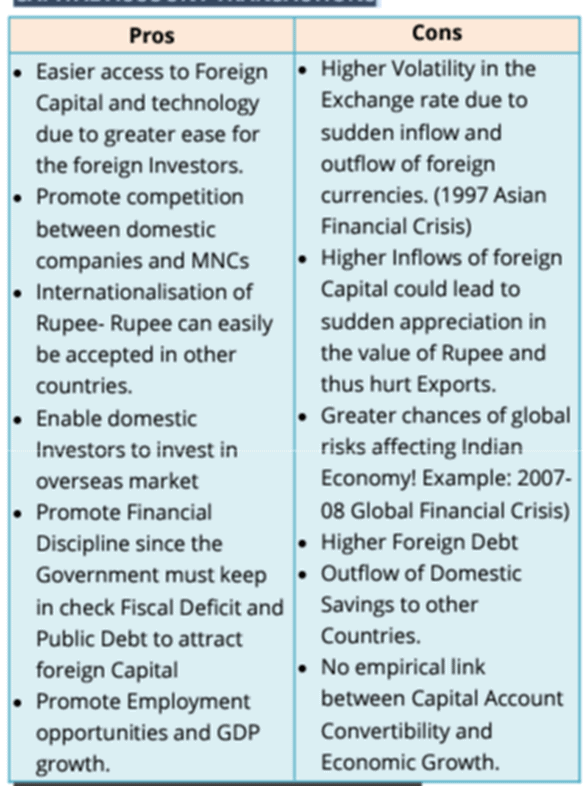
Is India Ready for Capital Account Convertibility? Prelims Snippets Global Food Security (GFS) Index
India is ranked at 71st place in the Global Food Security (GFS) Index 2021 among 113 countries. The Tarapore Committee has recommended that India should liberalise Capital Account Convertibility in a phased and gradual manner.
At the same time, it has laid down some pre-conditions to be met for the introduction of Capital Account Convertibility:
- Eliminate Revenue Deficit and ensure Revenue surplus.
- Substantial part of Revenue surplus should be earmarked for meeting repayment obligations.
- Strengthen the Regulation of Financial sector, including that of Banks. Reduce the NPAs of Banking sector and focus on reforms in Public Sector Banks (PSBs).
- To meet import and debt service payments, forex reserves should be adequate.
- The RBI should evolve policies to allow industrial houses to have stakes in Indian banks or promote new banks.
What Approach Should India Follow?
- Capital account liberalization should be regarded as a process and not an event i.e., it should be introduced in a phased and gradual manner.
- The degree and timing of capital account liberalization needs to be sequenced with other reforms, such as strengthening of banking systems, fiscal consolidation, trade liberalization and the changing domestic and external economic environments.
- India must focus more on liberalising inflows as compared to outflows. Among the kinds of inflows, FDI should be preferred for stability, while excessive short-term external debt needs to be avoided.
- For outflows, the hierarchy for liberalization must be - Corporates first, followed by financial intermediaries, and finally individuals.
6. Global Food Security (GFS) Index
India is ranked at 71st place in the Global Food Security (GFS) Index 2021 among 113 countries.
About Global Food Security Index
- Published by: London-based Economist Impact.
- Parameters: 58 unique food security indicators based upon factors of affordability, availability, quality and safety, and natural resources and resilience.
- Top Rankers: Ireland, Austria and UK.
- India's performance: India was placed at 71st place among 113 countries. India's ranking has been better than its neighbours such as Pakistan, Bangladesh, Sri Lanka, and Nepal. However, way behind China (34th).
7. Global Pension Index
The Indian pension system has been ranked 40th on overall Global Pension Index out of forty-three systems.
About Global Pension Index
- Published by: Collaborative research project sponsored by CFA Institute, Monash Centre for Financial Studies (MSFS) and Mercer.
- Purpose: Benchmarks retirement income systems around the world highlighting some shortcomings in each system and suggests areas of reform that would provide more adequate and sustainable retirement benefits.
- Parameters: Key strengths of retirement pension systems around three sub-indexes - adequacy, sustainability and integrity.
- Adequacy- What benefits are future retirees likely to receive?
- Sustainability- Can the existing systems continue to deliver, benefits in the future?
- Integrity- Are the systems well governed to encourage higher pension income?
- Top Performers: Iceland, Netherlands and Denmark India's performance: The Indian pension system has been ranked 40th on overall Global Pension Index out of forty-three systems. The Report has acknowledged government's initiatives such as National Pension System (NPS).
- The overall index value for the Indian system could be increased by
- Introducing a minimum level of support for the poorest aged individuals
- Increasing coverage of pension arrangements for the unorganised working class
- Improving the regulatory requirements for the private pension system
8. Conflict-Free Gold Standard
- The World Gold Council is an association consisting of the world’s leading gold mining companies. It helps to support its members to mine in a responsible way.
- There are growing concerns that the newly mined gold could be used to finance armed conflicts in the countries. Thus, there is a need to ensure that the gold that is sold in the market does not indirectly finance such conflicts.
- In this regard, the World Gold Council has developed the Conflict-Free Gold Standard to help companies to provide assurance that their gold is not contributing to conflict.
- Thus, Conflict-Free Gold Standard provides assurance that their gold has been extracted in a manner that does not cause, support, or benefit unlawful armed conflict or contribute to serious human rights abuses or breaches of international humanitarian law.
9. Wealth Redistribution Council in Japan
Recently, Japan has launched Wealth Redistribution Council to tackle wealth disparities and redistribute wealth to households. This is considered to be new form of Japanese Capitalism.
About Wealth Redistribution Council
- Focus on creation of a “virtuous cycle of growth and distribution” of wealth.
- Idea is to combine the pro-growth policies with inclusive growth policies and directly shift wealth from companies to households.
Relevance For India
India has failed to prevent concentration of wealth and provide for equitable distribution of income. For instance, according to the agricultural census 2011, the percentage of the land ownership of the poor and vulnerable sections is quite poor- SCs (12%), STs (7.8%), Women (8%) etc. On similar lines, as per Credit Suisse, 1% of the wealthiest in India have increased their share in wealth from 40% in 2010 to 60% in the last five years. Going forward, richest 10% in India would take away the majority share of $ 5 trillion economy.
|
114 videos|289 docs|126 tests
|
FAQs on Economy: November 2021 Current Affairs - Indian Economy for State PSC Exams - BPSC (Bihar)
| 1. What is the current status of Discoms in India? |  |
| 2. What is the PM Mitra Scheme? |  |
| 3. What is Gati Shakti- National Master Plan? |  |
| 4. What are the pillars of Gati Shakti? |  |
| 5. What is Capital Account Convertibility? |  |
|
114 videos|289 docs|126 tests
|

|
Explore Courses for BPSC (Bihar) exam
|

|
